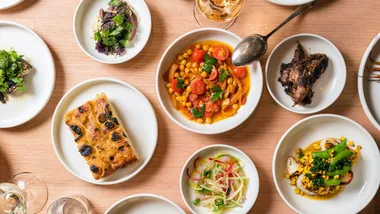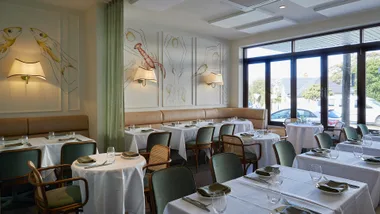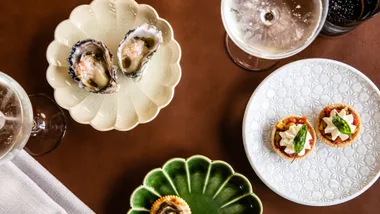Produce that serves as both a blank canvas and a standalone hero ingredient is a rare and special thing. And that’s just what two Western Australian chefs have been experimenting with and are now featuring in their cutting-edge restaurants.
Enter the Leeuwin Coast Akoya, a pearlescent oyster variety grown sustainably on the Western Australian coastline near Albany. A rich and meaty shellfish, the Akoya offers a variety of culinary possibilities.
The versatility of the Leeuwin Coast Akoya has it looking right at home on Melissa Palinkas’ menus at Ethos Deli + Dining Room and Young George. In her award-winning establishments you might find the Akoya buttermilk fried, olive oil poached or paired with chicken in an all-day omelette. With her food philosophy based on seasonal, local and sustainable produce, the Akoya fits her ethos well.
“The Akoya acts as natural filtration systems and create a positive ecosystem in our waters,” says Palinkas, who searched far and wide for biodegradable plastic wrap and insists use her environmentally friendly crates for produce. “As a chef with an ethical approach to food, that is important to me.”
Seth James, another acclaimed Western Australian chef, is just as passionate about sustainability and renowned for his innovative and inventive use of fresh produce. His restaurant, Wills Domain, champions local, seasonal produce with low-food miles. With the Akoya being harvested just a few miles away from the regional restaurant’s kitchen, it’s no surprise you’ll find poached Akoya with ginger and cucumber (a fresh twist on a classic Chinese dish) on the Wills Domain menu.

Seth James, Executive Chef at Wills Domain; Melissa Palinkas, Executive Chef at Ethos Deli + Dining Room and Young George
A refined restaurant committed to wild-harvested produce is the perfect place to experience the rich silkiness of the Akoya – until you learn you can make it yourself with the following recipes.
Homegrown and home-cooked? It doesn’t get better than that.
Below, how two of Australia’s top chefs are showcasing the Akoya.
Poached Leeuwin Coast Akoya with ginger and cucumber
For Seth James, Executive Chef at Wills Domain, the Akoya’s versatility brings endless opportunity.
“I’m enjoying experimenting with the Akoya,” James says. “Grilling or poaching them are my favourite way to cook them at the minute.”
With the Akoya being harvested just a few hours away from the award-winning Yallingup restaurant, it has found a place on James’ prix fixe menu as a much-loved snack. One of his favourite recipes is poached Akoya with ginger and cucumber, a play on a classic Chinese dish.

Poached Leeuwin Coast Akoya with ginger and cucumber
Serves 4
12 Leeuwin Coast Akoya, shucked
1 tbsp grapeseed oil
1/2 tsp sesame oil
35 gm knob ginger, finely shredded
6 tbsp Shaoxing wine
2 garlic cloves, finely grated
300 ml chicken stock
1 tbsp ginger vinegar
1 tsp sugar
1 tbsp light soy
6 spring onions, cut into lengths
1 1/2 tbsp cornflower
50 ml water
1 Lebanese cucumber, sliced into batons
2 tbsp roasted sesame seeds
Steamed rice, to serve
Remove Akoya from the shell and remove the abductor muscle from both sides. Rinse through cold water and remove the beard from the Akoya.
Bring a pan to smoking hot, add all oil and ginger and stir-fry until golden brown. Deglaze pan with Shaoxing wine.
Add garlic, stock, vinegar, sugar and light soy and bring to the boil. Add spring onions and simmer for two minutes.
Make slurry from the cornflour and water and whisk into the pan.
Add Akoya and poach for 3 minutes. Check seasoning, adding light soy to taste.
Buttermilk-fried Leeuwin Coast Akoya with smoked citrus emulsion and pickled lemon skin
“The versatility of the Akoya is exciting to me as a chef,” says Melissa Palinkas, Executive Chef at Ethos Deli + Dining Room and Young George. “I enjoy being able to experiment with different techniques and flavours to create a range of dishes for my guests. There seems to be no limit to the ways in which you can cook with this very unique product.”
“Safeguarding the planet for future generations is something I’m very passionate about. It’s taken a lot of effort and money to get to where we are now at both our venues but it’s worth it. Now we have a culture of zero waste and it’s just who we are. Working with like-minded producers, like Leeuwin Coast, is a part of that.”

Buttermilk-fried Leeuwin Coast Akoya with smoked citrus emulsion and pickled lemon skin
Serves 4
- 12 Leeuwin Coast Akoya Canola oil, for frying
Seasoned flour:
100 ml buttermilk
200 gm potato flour
100 gm rice flour
1 tsp salt
1 tbsp dried oregano
1 tsp white pepper
1 tsp smoked paprika
1 tsp garlic powder
1 tsp onion powder
Smoke citrus emulsion
2 egg yolks
1 tsp smoked paprika
1/2 tsp Dijon mustard
15 ml lemon juice
1 tsp salt
250 ml grapeseed oil
Pickled lemon skin
Spent lemon husk of 1 lemon, juice and peel reserved, pith removed
2 tsp sea salt
1/2 tsp citric acid
60 ml water
Make the pickled lemon skin two days in advance. Start with peeling the outside of the spent lemon husk – the lemon juice will go into the emulsion. Finely julienne peel, add salt and citric acid and leave for 24 hours. After 24 hours, add the water and leave overnight.
Shuck Akoya and rinse in ice-cold water. Place into a small stainless-steel bowl and pour over buttermilk. Leave overnight.
Clean shells and set aside. Combine all flours and spices and set aside.
In a bowl, whisk egg yolks with smoked paprika, mustard and lemon juice. Stream in grapeseed oil until emulsified. Season with salt and adjust as needed.
To assemble, coat each Akoya in seasoned flour and place on a rack.
Heat shallow pan with oil. When in reaches 190°C, fry Akoya in two batches of six, until crisp.
Take pickled peel from the solution. Dice very finely and place in a little olive oil.
To serve, place the smoked citrus emulsion into a sauce bottle and squeeze a good amount onto each reserved shell.
Place Akoya on top of the emulsion and spoon a little pickled lemon skin on top. Repeat with remaining Akoya.
Brought to you by Harvest Road










